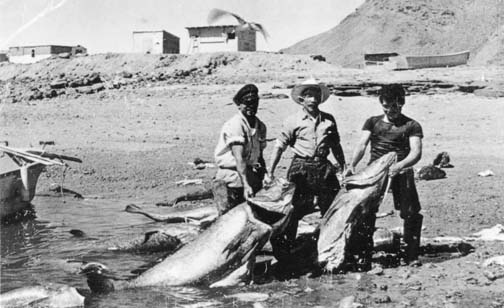
Totoaba Full Circle
![]()
|
Tony Reyes of San Felipe, Baja California, Mexico, left, with Papa Fernandez, Chi Chi Fernandez, and totoaba, Gonzaga Bay, c. 1953. |
THE OLD COMMERCIAL FISHERMAN BECOMES THE ENDANGERED
TOTOABA'S BIGGEST ADVOCATE
By Gene Kira, Nov. 26, 2001, as published in Western Outdoor News:
When you shake hands with Tony Reyes Baca of San Felipe, Baja California, Mexico, it's like grasping a gnarled piece of old driftwood. The fingers are misshapen and the hand refuses to close completely. You look down and see that it is tormented from many years of strenuous work.
Tony is one of those legendary, old-time Mexican pangueros, born in the era of canoas (canoes), remos (oars), and coarse handlines that battled majestic fish. When you see the old photos of Tony, your eyes find it difficult to believe. There is a handsome young man, smiling in the harsh sun. He is striped to the waist, his body cut with muscular definition, and all around him are enormous fish, many of them the size of marlin.
|
|
These are the giant totoaba, a cousin of the white seabass, that once swam the northern Sea of Cortez in schools so thick they could literally be harpooned with one's eyes held shut. These fish grew to well over 200 pounds in weight, and there are records of some that approached 300 pounds, and even a few stories of fish that exceeded that size.
Beginning about 1920, the totoaba were caught by Mexican fishermen using only handlines, and the stocks were not appreciably depleted. In the early years, most of the fish were taken solely for their air bladders, which were dried and sold for use in a Chinese soup that was known as seen kow. The carcasses of the enormous totoaba were left on the beaches to rot. Then, traders began buying the fish for as little as five cents each, and transporting them to the U.S. By 1942, over 4-million pounds of totoaba were exported to the Southern California wholesale market, and still the fish resisted the pressure successfully. But in the 1950s, dynamite and gill nets were used to intercept the totoaba before they could spawn in the estuaries of the Colorado River, and they became almost extinct within a few years. A potentially enormous Northern Cortez sportfishing industry was nipped in the bud as the fantastic schools of giant fish disappeared.
Tony Reyes witnessed that disastrous decline, and it must be admitted that in the early days, he was one of the many at San Felipe who participated in the over-fishing, both as a commercial fisherman and as a sportfishing guide; his work-worn hands attest to the brutally heavy loads that he pulled in an earlier era when it was not understood how quickly a species can be destroyed by overfishing.
|
|
But no more. As the operator of Tony Reyes Fishing Tours and the sportfishing panga mothership Jose Andres out of San Felipe, Tony is today one of Baja California's most outspoken advocates of the federally protected but still-embattled totoaba, speaking out when others dare not to against the widespread poaching now being committed by both sport and commercial anglers in the northern Cortez.
In December of this year, the old totoaba fisherman, Tony Reyes, will come full circle. His sportfishing boat, the Jose Andres, will host a group of biologists from the Marine Sciences Department of the Autonomous University of Baja California at Ensenada, where, in a little-known research program, totoaba have been spawned and raised in special enclosures.
Next month, portable tanks containing live totoaba will be brought overland from Ensenada and loaded aboard the Jose Andres. The rare and magnificent fish will be taken to a location about 15 miles from San Felipe, and there they will be released to grow and reproduce their kind for the benefit of future generations.
When those young totoaba are returned to their historic home in the northern Sea of Cortez, Tony Reyes will not be the captain of the Jose Andres. That responsibility today falls on the shoulders of his son, Tony Reyes Jr. But the old fisherman with the gnarled hands will be on board for sure, and if I know Tony, he'll be smiling brighter than anybody else.
(Related San Felipe articles and reports may be found at Mexfish.com's main San Felipe information page. See weekly fishing news, photos, and reports from the major sportfishing vacation areas of Mexico including the San Felipe area in "Mexico Fishing News.")
MEXICO FISHING INFO SAN FELIPE FISHING INFO "WEEKLY MEXICO FISHING NEWS" FISH PHOTO GALLERY
